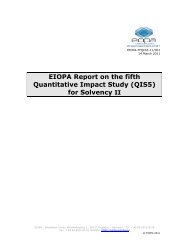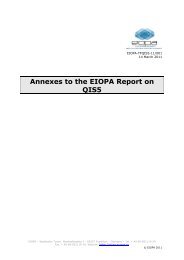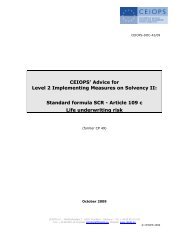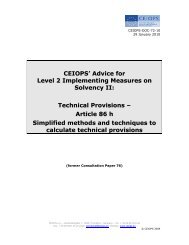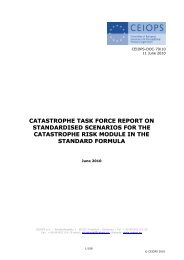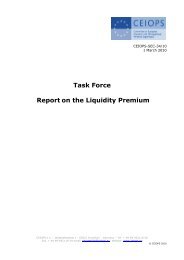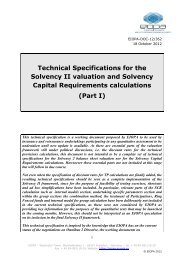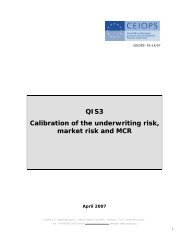Answers to the European Commission on the ... - Eiopa - Europa
Answers to the European Commission on the ... - Eiopa - Europa
Answers to the European Commission on the ... - Eiopa - Europa
Create successful ePaper yourself
Turn your PDF publications into a flip-book with our unique Google optimized e-Paper software.
Segmentati<strong>on</strong><br />
B.79 In general terms, an assessment of underwriting risk involves an<br />
estimati<strong>on</strong> of <str<strong>on</strong>g>the</str<strong>on</strong>g> variability of <str<strong>on</strong>g>the</str<strong>on</strong>g> underwriting result of <str<strong>on</strong>g>the</str<strong>on</strong>g><br />
undertaking. This requires underlying data that are sufficiently<br />
homogeneous with respect <str<strong>on</strong>g>to</str<strong>on</strong>g> emergence, development and statistical<br />
pattern of claims. For a heterogeneous product, such as commercial<br />
multi-peril or miscellaneous liability insurance, experience may be<br />
segregated in<str<strong>on</strong>g>to</str<strong>on</strong>g> more homogeneous groupings.<br />
B.80 A suitable segmentati<strong>on</strong> of <str<strong>on</strong>g>the</str<strong>on</strong>g> book of business might be explicitly<br />
defined within <str<strong>on</strong>g>the</str<strong>on</strong>g> formula, or some flexibility could be allowed so that<br />
nati<strong>on</strong>al particularities can be taken in<str<strong>on</strong>g>to</str<strong>on</strong>g> account. The <strong>on</strong>going<br />
relevance of <str<strong>on</strong>g>the</str<strong>on</strong>g> present EU classificati<strong>on</strong> 153 requires fur<str<strong>on</strong>g>the</str<strong>on</strong>g>r<br />
c<strong>on</strong>siderati<strong>on</strong> with stakeholders. A standard classificati<strong>on</strong> that is more<br />
closely aligned with actual undertaking behaviour should have positive<br />
c<strong>on</strong>sequences for risk management.<br />
B.81 Both premium and reserve risk may be analysed <strong>on</strong> <str<strong>on</strong>g>the</str<strong>on</strong>g> basis of<br />
homogenous segments of <str<strong>on</strong>g>the</str<strong>on</strong>g> portfolio <str<strong>on</strong>g>to</str<strong>on</strong>g> take <str<strong>on</strong>g>the</str<strong>on</strong>g> particularities of <str<strong>on</strong>g>the</str<strong>on</strong>g><br />
single segments in<str<strong>on</strong>g>to</str<strong>on</strong>g> account. Such a segmented approach <str<strong>on</strong>g>to</str<strong>on</strong>g><br />
underwriting risk would present <str<strong>on</strong>g>the</str<strong>on</strong>g> problem of how <str<strong>on</strong>g>to</str<strong>on</strong>g> aggregate<br />
individual risk charges. Simply adding up <str<strong>on</strong>g>the</str<strong>on</strong>g> individual charges would<br />
neglect diversificati<strong>on</strong> effects between different lines of business. This<br />
may lead <str<strong>on</strong>g>to</str<strong>on</strong>g> an overestimati<strong>on</strong> of <str<strong>on</strong>g>the</str<strong>on</strong>g> required risk capital.<br />
B.82 There are two approaches <str<strong>on</strong>g>to</str<strong>on</strong>g> deal with this problem:<br />
• <strong>on</strong>e may determine premium (or reserve) risk capital charges for<br />
each segment and calculate <str<strong>on</strong>g>the</str<strong>on</strong>g> overall premium (or reserve) risk<br />
capital charge using capital aggregati<strong>on</strong> methods; or<br />
• <strong>on</strong>e may determine <strong>on</strong>ly <str<strong>on</strong>g>the</str<strong>on</strong>g> first two moments of <str<strong>on</strong>g>the</str<strong>on</strong>g> distributi<strong>on</strong><br />
of <str<strong>on</strong>g>the</str<strong>on</strong>g> premium (or reserve) risk for each segment and calculate<br />
<str<strong>on</strong>g>the</str<strong>on</strong>g> first two moments of <str<strong>on</strong>g>the</str<strong>on</strong>g> overall premium (or reserve) risk<br />
using a correlati<strong>on</strong> matrix for <str<strong>on</strong>g>the</str<strong>on</strong>g> sec<strong>on</strong>d moments. Assuming <str<strong>on</strong>g>the</str<strong>on</strong>g><br />
overall premium (or reserve) risk <str<strong>on</strong>g>to</str<strong>on</strong>g> have a specific twoparametric<br />
probability distributi<strong>on</strong>, <strong>on</strong>e may <str<strong>on</strong>g>the</str<strong>on</strong>g>n calculate <str<strong>on</strong>g>the</str<strong>on</strong>g><br />
overall premium (or reserve) risk capital charge.<br />
B.83 The Dutch Financial Assessment Framework, for example, follows <str<strong>on</strong>g>the</str<strong>on</strong>g><br />
first approach. The advantage of this approach is that for <str<strong>on</strong>g>the</str<strong>on</strong>g><br />
calculati<strong>on</strong> of <str<strong>on</strong>g>the</str<strong>on</strong>g> capital charges of <str<strong>on</strong>g>the</str<strong>on</strong>g> single segments <str<strong>on</strong>g>the</str<strong>on</strong>g> underlying<br />
probability distributi<strong>on</strong> of <str<strong>on</strong>g>the</str<strong>on</strong>g> risk can be chosen according <str<strong>on</strong>g>to</str<strong>on</strong>g> <str<strong>on</strong>g>the</str<strong>on</strong>g><br />
particularities of <str<strong>on</strong>g>the</str<strong>on</strong>g> segment. The disadvantage of this approach is<br />
that a standardised aggregati<strong>on</strong> of <str<strong>on</strong>g>the</str<strong>on</strong>g> risk capital charges of <str<strong>on</strong>g>the</str<strong>on</strong>g><br />
segments is problematic. To be in a positi<strong>on</strong> <str<strong>on</strong>g>to</str<strong>on</strong>g> aggregate <str<strong>on</strong>g>the</str<strong>on</strong>g>m in a<br />
ma<str<strong>on</strong>g>the</str<strong>on</strong>g>matically precise manner, <str<strong>on</strong>g>the</str<strong>on</strong>g> complete dependence structure of<br />
<str<strong>on</strong>g>the</str<strong>on</strong>g> risks has <str<strong>on</strong>g>to</str<strong>on</strong>g> be known. This is rarely <str<strong>on</strong>g>the</str<strong>on</strong>g> case.<br />
B.84 The Swiss Solvency Test follows <str<strong>on</strong>g>the</str<strong>on</strong>g> sec<strong>on</strong>d alternative. According <str<strong>on</strong>g>to</str<strong>on</strong>g><br />
153 The insurance classes defined in <str<strong>on</strong>g>the</str<strong>on</strong>g> First Council Directive 73/239/EEC.<br />
252






